Silence Is Not an Option: The Art and Activism of Betty LaDuke
Much of the primary source information in this essay was drawn from resources held in the CALYX Archives. Material drawn from the archives is indicated in italics. CALYX Press is currently accepting donations to facilitate continued collaboration with the Knight Library at the University of Oregon to curate, catalog, and digitize this collection. To donate in support of this project, please contact Beth Russell, Acting Executive Director, at director@calyxpress.org, or make a donation through our website at www.calyxpress.org.
In 1968 Betty LaDuke’s No Exit was on display at the Capitol Coffee Shop in Salem, OR. The painting depicted three adult nudes trapped together in a room but incapable of fulfilling each other’s needs for love or compassion. A waitress who found it offensive removed it to a janitor’s closet, triggering a public debate around issues of art and censorship. The artist–who was and would remain the only female member of the art faculty at Southern Oregon State College for the next seventeen years—was thirty-five years old. She was cross-culturally experienced, recently divorced, newly remarried, and parenting a young daughter while working full-time in a professional field. She was living life as the women’s movement had imagined it, defining—by example—what liberation might mean. In the decades to come, Betty LaDuke would continue to cross boundaries, challenge assumptions, and resist oppression, championing perspectives that mainstream culture ignored, suppressed, or denied and forging local friendships and global alliances in support of women’s voice and vision around the world.
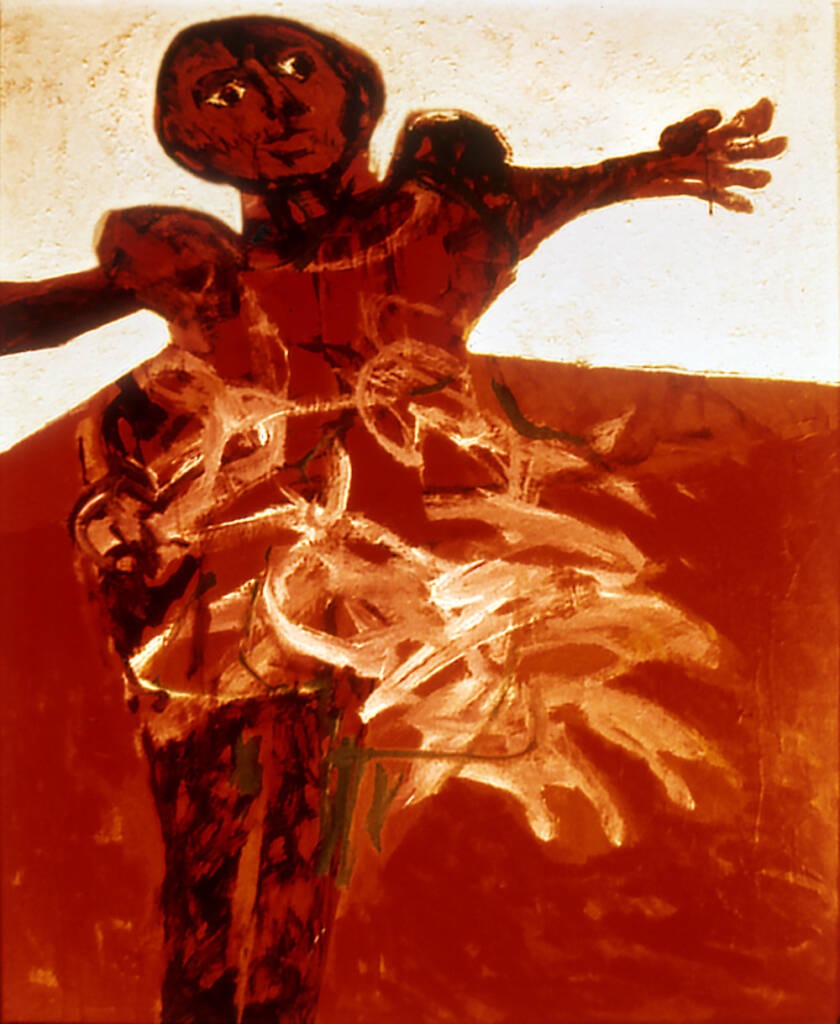
“Play Free: All Children, Everywhere” (1966)
Though they are often integrated into three dimensional totemic structures, many of the paintings Betty produced at the end of the 1960s have the visual qualities of photographs. They are images captured quickly, using rapid brush strokes, addressing political issues or detailing specific moments in the life of her rapidly maturing daughter, sometimes within the same frame. Like the painting Play Free: All Children, Everywhere, they are studies in dynamic energy, capturing both public and private experiences of liberation and directly confronting social realities.
After her second child, a son, was born in 1970, Betty’s work became more intimate, illuminating everyday experiences within the domestic sphere: the ritual of nursing, the joy of unstructured play and spontaneous discovery, the development of independent opinions and identity within and beyond the family constellation.
Throughout the 1970s, Betty observed the community of women with whom she shared the experience of parenting facing the challenge of establishing their identities outside the home. In our relationships, she remembers, we pressed to be free from society’s constraints in order to recreate new roles that better suited our changing individual and family needs. As a means of recalibrating in response to these pressures, Betty began working on a series of paintings titled Oregon Landscapes: A Mythical Feminine View, in which elements of the landscape—coastal rock formations, a fallen redwood, a pair of sunflowers, the ocean at sunrise—are impregnated with human forms.
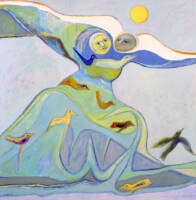
“Ocean Sunrise” (1978)
CALYX would first publish work by Betty LaDuke in the Summer of 1978 (Volume 3:1), featuring black and white prints of the paintings Ocean Sunrise, The Grand Canyon, Summer Joy and Wedding Ritual, and next in the Fall of 1982 (Volume 7:2), which included a similar print of Summer’s End. Drawn from the body of work Betty produced in the 1970s, the images selected illuminate observed moments that seemed like the brief flickering of candlelight, when people turned to each other with gentleness and love. In her journal Betty wrote: These images are my response to a sensuous, joyous, and sometimes humorous pleasure that transcends a particular time and place. Politically imposed barriers vanish as the landscape becomes filled with people reaching out to one another. Human survival depends on our ability to communicate and express love.
This aesthetic developed partly in response to the influence of her first sabbatical. In 1972, Betty traveled alone to India, where she encountered a vast new realm of sensitivity to different colors, shapes, sounds and visions. In her sketches, etchings and paintings she documented the contrast between the physical hardships and spiritual joy shaping the lives of the people she encountered, observing that: Boundaries between the natural and spirit world vanished. Life was not static, and the people’s varied sculptural forms combined human with bird, fish, crocodile, plant and animal motifs. Subsequent trips to countries including Sri Lanka, Bali, Java, Sumatra, Thailand, Papua New Guinea, Australia, Borneo and Sulawesi were sponsored by public institutions and private organizations seeking to deepen cross-cultural understanding and elevate awareness of women’s issues. As Betty’s cultural and mythical perspectives continued to expand, so did her awareness of the importance of the traditional arts practiced by women around the world.
Betty first met CALYX co-founder Margarita Donnelly in 1977. The two women felt immediately the potential of that convergence. Both had lived in Latin America for extended periods of time, Margarita as a child with her parents and Betty as a scholarship art student at the Instituto Allende in San Miguel, Mexico from 1953–1956. After Betty and Margarita met, Margarita began making regular visits to Betty’s studio in Ashland. The two women discovered that they shared a commitment to the liberation ideologies informing revolutionary politics in Latin America and a conviction that art was a potent response to entrenched patterns of social injustice. In the Summer of 1983, CALYX Journal Volume 7:3 featured Betty’s Nicaraguan Sketch on the cover and included a short photo essay: “Nicaragua: Women as Artists and Artisans” by Betty LaDuke. The three black and white photos included, titled Black Clay Pottery by Carmen Rodriguez, Matagalpa Painter Nieve Andina Arnesto, and Sandino’s Gourds document the creative work of women Betty had met while visiting Nicaragua, providing a pro-revolutionary perspective.
Prior to meeting Margarita Donnelley, Betty recalls, she felt isolated as an artist. Her art was challenging rather than comforting, political rather than commercial; consequently, she had neither an agent nor gallery representation. Betty’s relationship with CALYX was thus intensely affirming, as CALYX’s stated mission was to create space for women’s voices and visions, raise awareness of women’s issues, and broaden regional awareness of international women’s art, and Betty, who had been actively engaged in that work for over a decade, was to provide a provocative model for other artists and writers CALYX would publish over the years. After she began her work with CALYX, Betty published a series of books focused on the work of women artists around the world. The first of these, Compeñeras: Women, Art & Social Change in Latin America, was published by City Lights Books in 1985. Written in the spirit of reciprocity, the book is an active acknowledgement of Betty’s awareness of the privilege and power her role as a teacher granted in allowing her to bring attention to the work of women in Latin America.
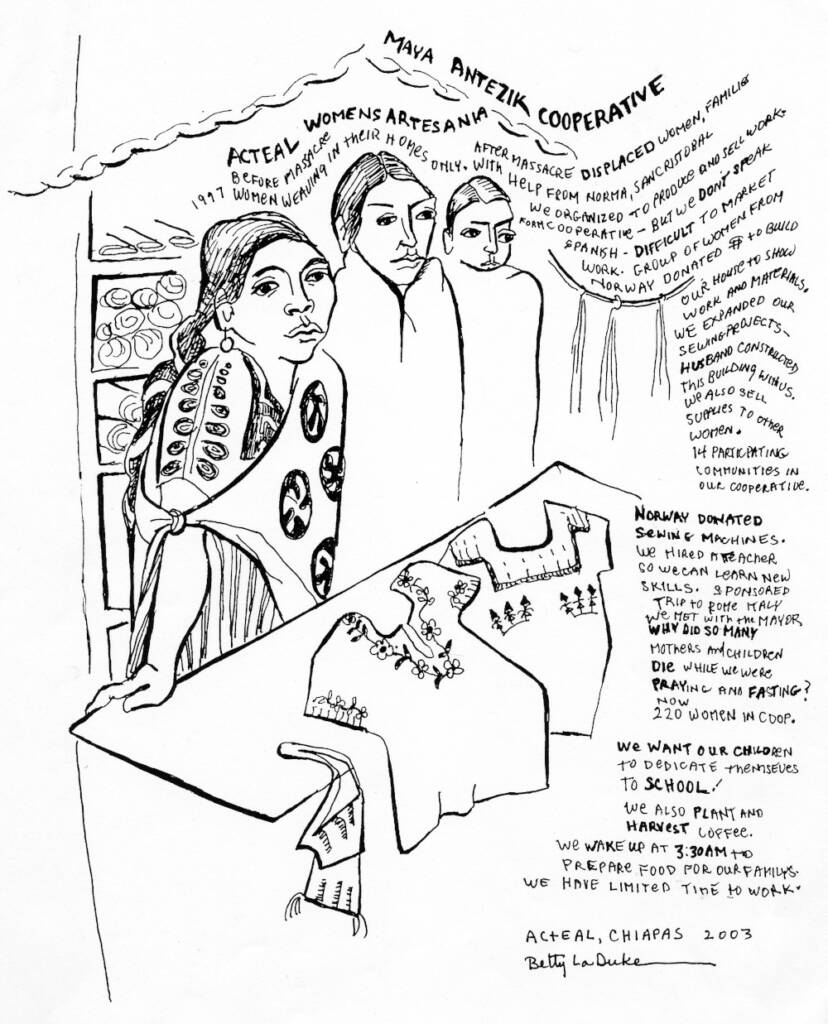
“Maya Antezik Cooperative” (2003)
In the Summer of 1986, CALYX’s tenth anniversary issue featured the painting Pachamama and the Magic Leaves as a cover image and included black and white renditions of three new paintings: Earth Mothers, Latin America: Timeless Time, and Latin America: Homage to the Mothers of the Disappeared. The political realities facing communities in Latin America was also a focus of work Betty published in Volume 21:2 (Summer 2003), which included two sketchbook images, Maya Antezik Cooperative and No Al Plan Panama, in which simple line drawings from the field are juxtaposed with notes documenting the spoken testimony of the people depicted. The conversational nature of these images speaks to the respect with which Betty treats the people and landscapes she renders. Her sketches navigate, with wisdom and humility, the common ground between artist and subject, self and other, observer and observed.
This approach is also evident in later work included in Volume 23:1 (Summer 2006), which featured her Syrian painting Prayers for Peace, Sayyida Zanabal Shrine, Damascus, Syria. The back cover featured a photo of Betty LaDuke sketching in the courtyard of the Grand Omayyad Mosque. The issue included two more of Betty’s sketches from the Syria notebooks: Victoria Exhibition Aleppo, Syria and Sharab, Bagdad Cafe, Syria. These pieces harken back to Betty’s early work as a muralist, but they are also intimate portraits. Each figure depicted is a specific person within a group; each image captures a unique constellation of relationships manifesting at a specific moment in space and time.
According to Betty, it was her work with women artists in Latin America that led to her awareness of and curiosity about the cultural link between Latin America and the continent of Africa. Over the next decade, Betty’s work in Africa would culminate in two books, Africa: Through the Eyes of Women Artists (Africa World Press, 1991) and Africa: Women’s Art, Women’s Lives (Africa World Press, 1997). These books emphasize the reciprocal nature of Betty’s relationship with the women artists she worked with in countries as diverse as Nigeria, Mali, Senegal, Uganda, Kenya, South Africa, and Eritrea. Betty’s own art, an art of cause and consciousness, is positioned in dialogue with the work of the artists featured, drawing attention to the power of local action rooted in traditional wisdom, organic relationship, and sustainable strategies for resource management, celebrating these as solutions that empower and dignify the lives of women and their families.
CALYX Journal Volume 26:2 (Winter 2011) featured work inspired by Betty’s experience in Africa: Africa After War, and Africa: Reshaping the Land. These paintings are significant because they speak to the special relationship that Betty developed with the African nation of Eritrea. In the early nineties, Eritrea had only recently won its independence from Ethiopia after a devastating thirty-year war. Betty visited a number of camps that housed those displaced by the conflict. She also interviewed women who had served as female soldiers and were working to redefine themselves as artists. Over the next seven years, between 1993 and 2002, sponsored by the US Embassy and aid agencies working to promote stability in the region, Betty visited Eritrea eight times, teaching and learning in support of restoration efforts there.
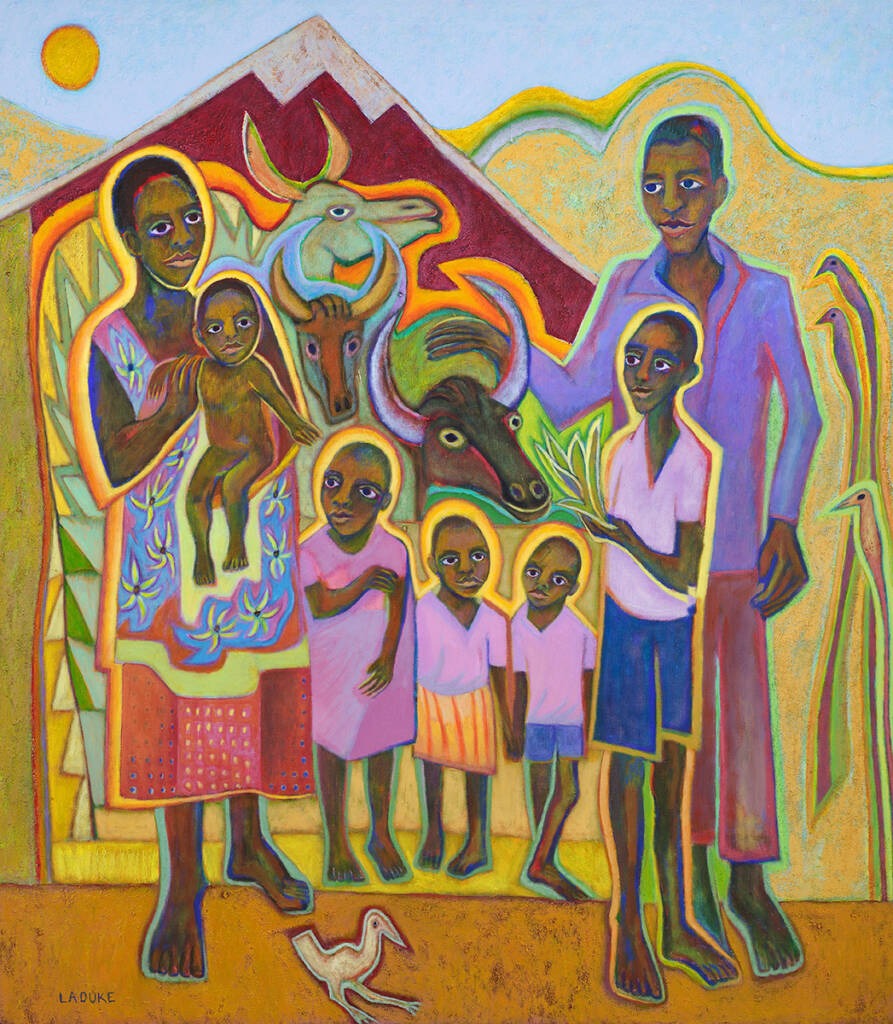
“Uganda: Dreaming Cows” (2003)
It was through her work in Eritrea that Betty began working with Heifer International (HI), an aid organization founded in 1944 to support agriculturally based economic development in Africa, Asia, Eastern Europe, Latin America and the United States. In 2007, Betty was invited to create a mural for the education center at Heifer International headquarters in Little Rock, AR. This manifested as the Dreaming Cows Mural Project, 27 larger than life panels, each approximately 7’ x 4,’ cut and shaped from thick gauge plywood and vibrantly painted to depict a specific project sponsored by Heifer.
The use of life-sized, life-shaped images in work commissioned to celebrate the relationship between land, plants, animals, people, and the food they collaborate to produce is also a structural theme in Bountiful Harvest: From Land to Table, a series of free-standing images commemorating the contributions of agricultural workers in Oregon. Panels from the series are now permanent installations at the Oregon State Capitol Building, Oregon State University, Southern Oregon University, Willamette University, and the Rogue Valley International Airport in Medford, Oregon. It brings Betty joy to know that migrant laborers flying in and out of Medford see their work celebrated in these images, and know that they are being welcomed, thanked, and seen.
In 2019, Betty journeyed to Nogales, Arizona, where she crossed into Nogales, Mexico with the Samaritans. Border Crossing # 4, one of four Border Crossing images included in the Summer/Fall 2017 issue of CALYX (Volume 30:1), commemorates the migrant experience. The figure depicted is haunted by the twin ghosts of famine and displacement, suggesting that hunger is a phenomenon all people face when cultural and ecological systems are disrupted. Here, Betty forces us to confront the fact that food insecurity is a global rather than a third-world problem. Like the image itself, the title foreshadows the collapse of the false construct of the global south. Other images in this series include Border Children: No More Cages (Volume 30:1), Caravans: Between Dream and Reality, Hungry for Hope, Stubborn Hope, Desert Cross, and Build Bridges Not Walls, many of which are currently being shown as part of Betty’s Social Justice series.
Also included in this series are five totemic images inspired by the 2016–2017 Dakota Access Pipeline protests. Published in CALYX 30:1, Standing Rock Totem #1, Standing Rock Totem #2, and Standing Rock Water Protectors #3-5 are Betty’s response to a photo, originally published in Time Magazine, of a tall pole at Standing Rock decorated with signs pledging support from people all over the world. The totems speak to the dynamic power of people joined in solidarity, suggesting that through collective action, humans have the potential to become protectors as well as protestors, participants rather than spectators, not merely sympathetic observers, but agents of essential change. The totems are tall because Betty, who had undergone hip and knee replacement surgeries in the previous year, could not attend the protests, and wanted to be able to look across the distance between herself and the collective action unfolding in defense of indigenous land.
Betty LaDuke, now in her nineties, refuses to stand down. In pandemic isolation, responding in part to to the collective cultural trauma being relentlessly projected by the news media and more locally to the fires that were ravaging Southeast Oregon, Betty began work on a series of freestanding totemic figures exploring climate disruption and its personal and political consequences. Currently exhibited under the title Fire, Fury and Resilience, these images include such titles as Cyclones from Alabama to Mozambique, Easter Sunday Flu, Pandemic Agony and Resilience, The Vaccine, What to Believe, This Too Shall Pass, Dreaming Peace, Am I Next? and the Angelou-inspired ekphrastic Still (We) Rise. The figures depicted bear fearless witness to adversity and resilience, pushing back against the clamor of commercialism and the culture of despair.
To watch Betty at work is to witness playful shaping, sensation resolving into image as meaning unfolds. Alone in [her] studio, Betty says, in the wake of post-pandemic isolation and in response to our collective need to be together again, the world rushes in and she has a compelling need to give form to the local and global events reshaping our lives. While she works, she listens to NPR or the local college station, or to Big Joe Turner, King of the Blues. The materials she’s working with and the material she’s listening to converge, and from this convergence, Turtles emerge.
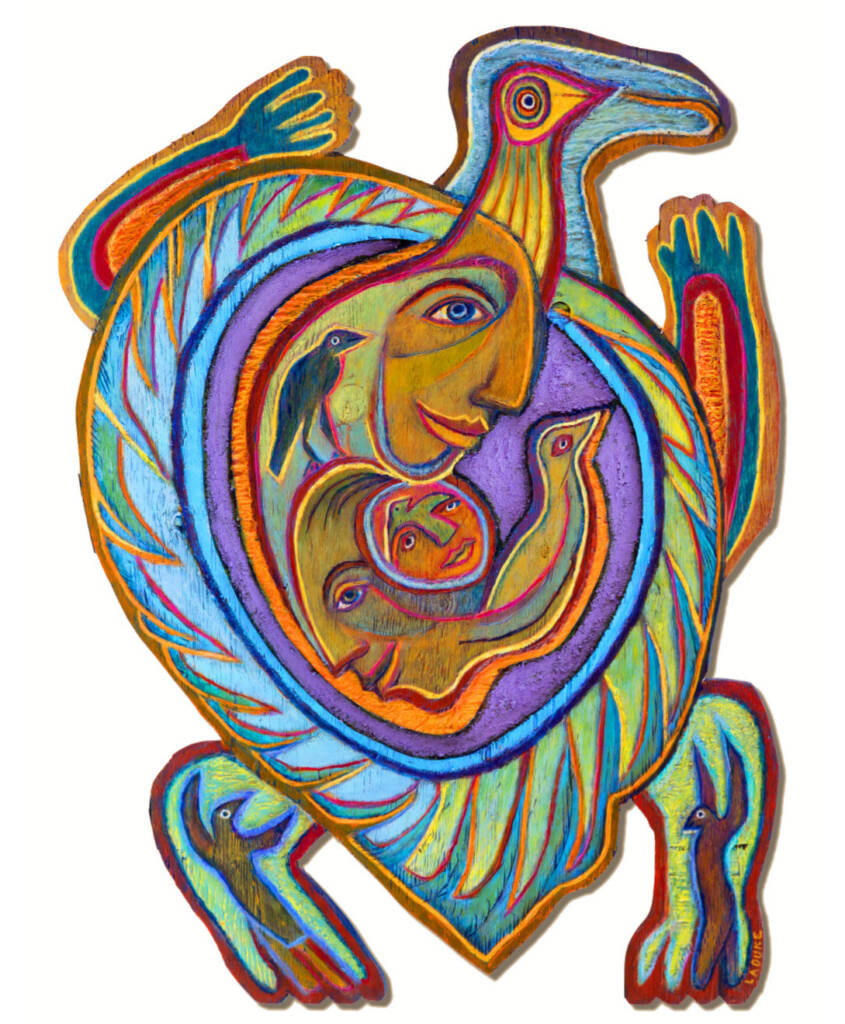
“Turtle Water Protector” (2001)
The cover of Volume 33:2 (Summer/Fall 2022) featured Turtle Love, an image from Betty’s Turtle Wisdom series. Betty speaks of the turtles as visitations, and is firm in her conviction that they have come to invite conversation rather than provide answers. When you look into the eyes of any of the thirty-one turtles that have manifested so far, you find a keen intelligence peering back at you. This is the world we live in, the Turtles say. What can you offer? What does the world require of you? Like Betty, the turtles invite reciprocal engagement. Like Betty, they remind us that our thoughts and deeds have the power to shape the world. By bearing active witness to the lives of others, we transform suffering into shared experience and can, through compassionate action, move through despair into the sweet, wild heart of joy.
Raised by wolves on a cold island in the Salish glacial carve, Beth Russell holds an MFA in creative writing from Pacific University and is currently the Acting Executive Director at CALYX Press in Corvallis, OR. Her work has been published in Cloudbank Magazine, The Fishtrap Anthology, and the Oregon Literary Review.
